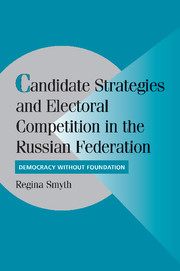 Candidate Strategies and Electoral Competition in the Russian Federation
Candidate Strategies and Electoral Competition in the Russian Federation Published online by Cambridge University Press: 25 July 2009
We are about to enter a new millennium. The world will be celebrating. But nobody will bring us any joy. I tell you, there is nobody to vote for in Russia.
Irina, unemployed mechanical engineerThe hallmark of any democratic election is a ballot that presents voters with distinct choices over candidates and parties and, presumably, policies. Candidates shape these choices through their electoral strategies – whether they run for office, whether they join a party, which district they contest, and how they campaign. Thus, candidates and their decisions shape election outcomes, ranging from national results – winners and losers, legislative factions and governments – to electoral infrastructure – information about voters' preferences and the viability of candidate or party strategies, coordination among voters and candidates, and cooperation in political parties. This chapter focuses on the first of these decisions: the decision to contest a seat in the State Duma.
As noted in Chapter 2, Russia's experience with competitive elections highlights an important paradox: Offering voters choices between different candidates does not always produce a consolidated democracy. The analysis of candidate entry provides the first illustration of this phenomenon. While the number of candidates contesting each seat in Russia has declined over time, it remains high. Many hopeless candidates vie for each national legislative mandate. Some races are decided by a small plurality of votes. Many candidates run as independents.
To save this book to your Kindle, first ensure no-reply@cambridge.org is added to your Approved Personal Document E-mail List under your Personal Document Settings on the Manage Your Content and Devices page of your Amazon account. Then enter the ‘name’ part of your Kindle email address below. Find out more about saving to your Kindle.
Note you can select to save to either the @free.kindle.com or @kindle.com variations. ‘@free.kindle.com’ emails are free but can only be saved to your device when it is connected to wi-fi. ‘@kindle.com’ emails can be delivered even when you are not connected to wi-fi, but note that service fees apply.
Find out more about the Kindle Personal Document Service.
To save content items to your account, please confirm that you agree to abide by our usage policies. If this is the first time you use this feature, you will be asked to authorise Cambridge Core to connect with your account. Find out more about saving content to Dropbox.
To save content items to your account, please confirm that you agree to abide by our usage policies. If this is the first time you use this feature, you will be asked to authorise Cambridge Core to connect with your account. Find out more about saving content to Google Drive.